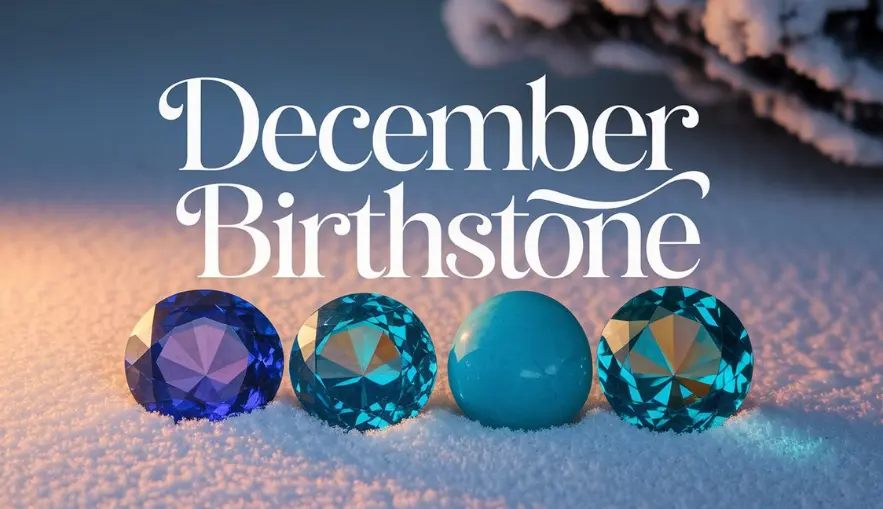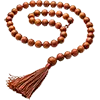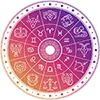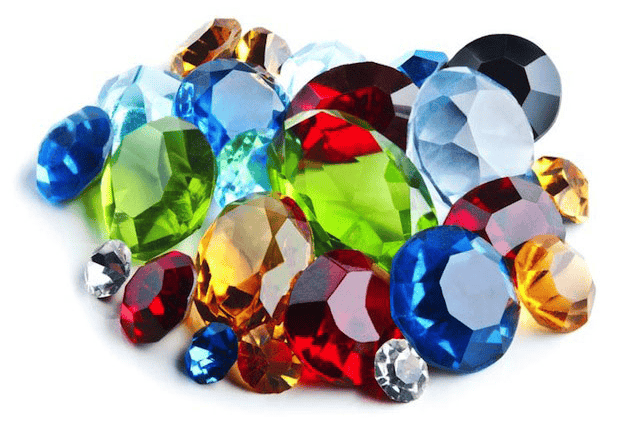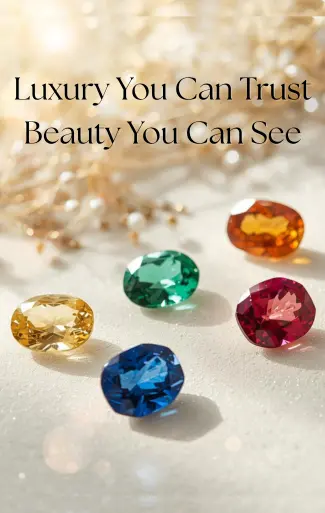December is one of few months that boasts not just one but four official birthstones – Tanzanite, Zircon, Turquoise and Blue Topaz. Each of these stones displays a unique shade of blue that beautifully mirrors the cool, crisp tones of the winter season. Among them, Turquoise is considered the most traditional choice, admired for centuries, while Tanzanite is the newest discovery, unearthed in Tanzania in 1967. These gemstones carry powerful meanings like wisdom, protection and new beginnings, giving December-born individuals a meaningful range of options to express their identity.
What is the Birthstone for December?
Being born in December is special – you get to pick from a variety of dazzling gemstones, each offering a different shade of blue and a unique personality. If you’re drawn to rich, deep tones, Tanzanite might be one for you. Its violet-blue shimmer often reminds people of sapphire and gives off an elegant and luxurious vibe. On the other hand, Turquoise gemstone carries a soft, sky-blue glow with earthy charm, long cherished by ancient cultures for its spiritual and healing qualities.
Zircon is another fascinating option. blue version is popular, but zircon also comes in golden, red and even clear varieties that sparkle like diamonds. If you prefer something bright and radiant, this gem could be your match. And lets not forget Blue Topaz – though not always listed among the traditional three, its a beloved choice for its icy blue clarity and calming energy.
One major advantage of December’s birthstones is their affordability. Despite their beauty and brilliance, these gems are often more budget-friendly than other precious stones. This makes it easier to choose something stunning without stretching your wallet – whether its a meaningful gift or a treat for yourself.
Turquoise Birthstone
Turquoise is a beautiful gemstone that people have loved for hundreds of years. It comes in lovely colors, from soft sky blue to greenish-blue. This gem is so well-known and special that the color “turquoise” was named after it – something that has happened with only a few other stones in the world.
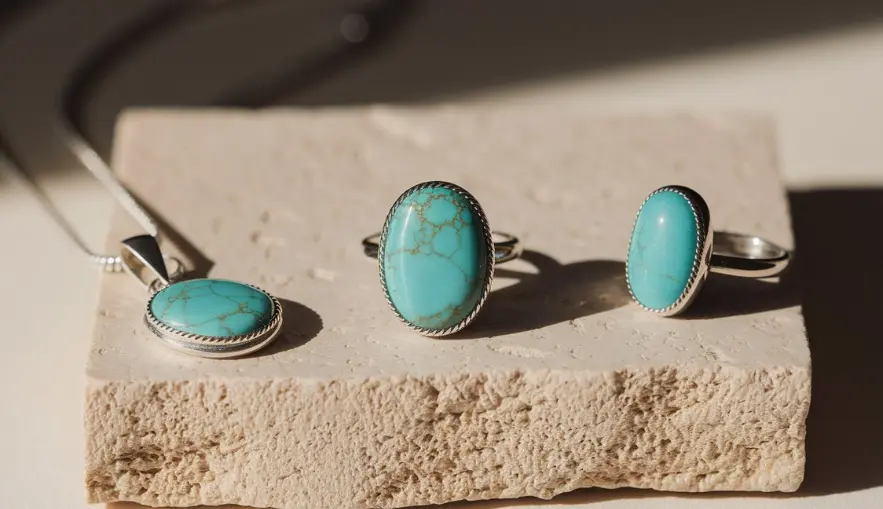
Name “turquoise” comes from 13th century. It was inspired by the French words pierre tourques, which means “Turkish stone” Thats because the gem was brought to Europe through trade routes that passed through Turkey.
In the past, Most valuable turquoise came from Persia, which is now called Iran. This type of stone is known as “Persian blue” even if it’s found in other countries today. Another ancient source of turquoise was the Sinai Peninsula in Egypt, where the gem was used in religious and cultural items for thousands of years.
Today, the United States is one of the biggest producers of turquoise. Arizona is especially famous for its high-quality stones, but other states like Nevada, New Mexico and Colorado also mine this gem. For Native American tribes, turquoise is more than just a stone – it has deep spiritual meaning and is often used in traditional jewelry and special cultural items.
Turquoise Birthstone Meaning and History
Turquoise forms in dry, desert-like places. Its made when water with copper, aluminum and phosphorus flows through rocks. Copper gives turquoise its bright blue color. If the stone also has iron or chrome in it, the color can shift toward green. Some turquoise stones have dark lines or web-like patterns called a matrix, which comes from the rock where they formed. In some styles, like Southwestern jewelry, a detailed “spiderweb” matrix is especially loved and adds to the stone’s beauty.
Even though turquoise looks stunning, its not a very hard gem. On the Mohs scale, which measures how hard a stone is, it scores between 5 and 6. Because it’s soft, ancient people often carved it into lucky charms or protective items. But this softness also means it can get damaged easily. It doesn’t do well with strong sunlight, perfume or body oils, so it should be worn carefully to keep it looking nice.
Turquoise has a long and rich history in many cultures. In ancient Egypt, it was used in royal jewelry and burial items. The most famous example is King Tutankhamun’s golden mask, which includes turquoise. In China, craftsmen were carving turquoise over 3,000 years ago. Native American stories say turquoise had magical powers – helping hunters aim better or even being found at the end of a rainbow.
Over time, people believed turquoise could bring protection, wealth and good luck. In Middle Ages, it was said to break apart when danger was near. In Hindu traditions, looking at turquoise just after seeing the new moon was believed to bring great fortune. In Tibet, people still see turquoise as a sacred gem that gives health and spiritual power.
Even modern-day royalty has admired turquoise. Duchess of Windsor, Wallis Simpson, wore a famous Cartier necklace made with both turquoise and amethysts. Turquoise is also the traditional stone for the 11th wedding anniversary and is seen as a symbol of long-lasting love. Giving someone a turquoise ring used to mean “don’t forget me”
Turquoise is more than just a pretty stone. It connects ancient legends with modern fashion, mixing culture, nature and beauty into one amazing gem. For anyone born in December, turquoise is a birthstone full of history, meaning and charm.
Where Does Turquoise Come From? (Origins)
Turquoise has been loved and mined for more than a thousand years. One of the oldest and most famous places where it was found is the Nishapur district in Iran. Turquoise from this area is known for its deep, rich blue color, which people often call “Persian blue” “sky blue” or “robin’s egg blue” Today, these names are used to describe turquoise that has this special blue shade, no matter where it comes from.
In the United States, New Mexico was once the top place for turquoise mining, especially before the 1920s. But now, most American turquoise comes from Arizona and Nevada. These states have many famous turquoise mines with unique names like Dry Creek, Fox, Emerald Valley and Easter Blue. Arizona’s Kingman mine is well-known for producing bright blue turquoise. Another famous mine, Sleeping Beauty, was once one of the top sources before it closed. It had been producing beautiful turquoise for over 40 years.
Outside the U.S., China is now the biggest producer of turquoise in the world. The Hubei Province in central China is the main area where high-quality turquoise is mined. This has made China an important part of the global turquoise market.
Turquoise usually forms in dry areas that have lots of copper in the ground. Thats why deserts and dry regions, like the American Southwest, are perfect places to find it. States such as Arizona, Nevada, Colorado, New Mexico and California have all produced large amounts of turquoise. Arizona’s Bisbee mine is especially famous and New Mexico’s Cerrillos Hills are one of the oldest known turquoise mining spots in North America.
Around world, turquoise is also found in other places with a long history of mining gems. These include Iran, where some of best-quality stones come from; Egypt, where turquoise was used in ancient times; and countries like Chile, Mexico and of course, China. All of these places help supply the world with this beautiful and meaningful December birthstone.
Turquoise Care, Cleaning & Durability
Turquoise is loved for its soft blue to greenish-blue colors and its natural patterns, which are often called “veins” It usually has a smooth surface that looks waxy or slightly shiny. While turquoise is a very pretty stone, it does need special care to stay in good condition.
On the Mohs hardness scale (which tells us how hard a gem is), turquoise ranks between 5 and 6. This means its softer than many other gemstones. Because of this, it can get scratched more easily and may break if it’s hit too hard or exposed to chemicals. This is especially important if turquoise is used in rings or jewelry that you wear every day. To make it stronger and more beautiful, some turquoise stones go through treatments. These may include adding color (dyeing), using resin to make the stone harder (stabilizing) or filling in small holes with special glue (epoxy). Sometimes, tiny metal pieces are added to give it a shiny look like pyrite.
Turquoise usually does fine under normal light, but too much heat can hurt it. High temperatures can make the color fade or even cause the stone to crack. Turquoise can also be damaged by strong chemicals, like harsh cleaners, perfumes, makeup or even the natural oils on your skin. Over time, these things can change the stone’s color or damage its surface.
To keep your turquoise looking its best, clean it gently. Use a soft cloth with lukewarm water and a little mild soap. Never use steam or ultrasonic cleaners, as the heat and shaking can harm the gem – especially if it has been treated. After washing, dry the stone carefully and store it away from harder jewelry so it doesn’t get scratched.
With the right care, turquoise can stay beautiful for many years. Its not just a lovely stone – it also carries deep cultural meaning and history. Taking care of it properly helps protect both its beauty and the special story it tells.
Turquoise Properties
Turquoise is a type of mineral made from copper, aluminum and phosphate that contains water. This special mix gives turquoise its beautiful blue and green colors. Because of the way its formed, turquoise is a bit soft. It ranks between 5 and 6 on the Mohs scale, which means it can get scratched or damaged if not handled carefully – especially when used in jewelry.
Most turquoise is microcrystalline, which means it doesn’t have visible crystals. Instead, it has a smooth and solid texture, similar to another gem called chalcedony.
This stunning December birthstone forms in nature as a “secondary mineral.” That means it doesn’t come straight from lava or melted rock but forms later, when water with a lot of copper in it moves through rocks that have aluminum and phosphorus. Over time, this process creates pieces or thin lines of turquoise inside those rocks.
Turquoise is often found near other blue and green copper-based minerals, such as:
- Chrysocolla
- Azurite
- Malachite
- Dioptase
- Shattuckite
These minerals show that turquoise comes from places with a lot of copper in the ground. They can also change how the turquoise looks, especially the patterns or colors around it – called the “matrix”
Tanzanite Birthstone
Tanzanite is a striking blue-violet gemstone that stands out for both its beauty and rarity. A unique variety of the mineral zoisite, it is found in only one place on Earth – a small mining area near Mount Kilimanjaro in Tanzania. Since its discovery in the late 1960s, tanzanite has quickly become one of the most sought-after modern gemstones.

Although the mineral zoisite had been known to science since the early 1800s, the captivating blue form wasn’t unearthed until 1967. This vivid coloration results from the presence of vanadium combined with heat, producing shades that range from soft sky blue to deep ultramarine, often tinged with violet undertones.
Tanzanite displays a phenomenon known as pleochroism, meaning the gem can show different colors – typically blue, violet or burgundy – depending on the viewing angle. Expert gem cutters must orient each stone carefully to emphasize its desirable hues and reduce the appearance of any naturally occurring brown tones. In fact, most of the tanzanite available today is gently heat-treated to enhance its blue and violet shades, giving it the brilliance that rivals sapphires.
This December birthstone measures 6.5 to 7 on the Mohs hardness scale, making it softer than many traditional gems. While its rich color and rarity make it ideal for special jewelry, its best worn in pieces like earrings or pendants where its less exposed to daily wear and tear. Its relatively lower hardness means extra care is needed to prevent scratches or damage.
Despite its recent emergence in the gem world, tanzanite’s appeal is timeless. Its limited supply and vivid velvety color make it a prized addition to any jewelry collection – whether or not you were born in December.
Tanzanite Birthstone Meaning and History
Although tanzanite is a newcomer among birthstones, it holds a fascinating place in modern gem history. The story began in 1962 when blue crystals found in Tanzania were identified as zoisite. But it wasn’t until 1967 that prospectors traced these beautiful stones to the Merelani Hills, revealing the primary source of this rare gem. Soon after, the gem was named tanzanite in honor of its birthplace.
It was American luxury jeweler Tiffany & Co. that helped introduce tanzanite to the world. Recognizing its international appeal, Tiffany launched a large-scale marketing campaign in 1968, positioning tanzanite as one of the most exciting gemstone discoveries of the 20th century. With its vivid hues, excellent clarity and availability in larger sizes, tanzanite quickly captured public attention.
Gemologists often regard tanzanite as the most important gemstone discovery since alexandrite in 1834. Beyond being a December birthstone, it is also the traditional gem for the 24th wedding anniversary, making it a symbol of long-lasting love and rare beauty.
The initial discovery of tanzanite is credited to Manuel de Souza, an Indian tailor and amateur prospector. Believing he had found a different mineral, he shared the samples with American geologist Dr. John Saul. Eventually, Dr. Saul’s father brought the stones to the Gemological Institute of America (GIA), where they were confirmed to be a new variety of vanadium-bearing zoisite.
Today, with mining operations slowing and supply limited to a few square miles of land, tanzanite continues to grow in value and significance. Its a modern gem with an ancient charm – perfect for those who want something truly one of a kind.
Where Does Tanzanite Come From? (Origins)
Tanzanite is one of the rarest gemstones in the world and can only be found in one place on Earth – the Merelani Hills in northern Tanzania, right near the famous Mount Kilimanjaro. This area is small, rocky and filled with grassy slopes and bushes, with the snowy top of Kilimanjaro standing tall in the background.
The gemstone is mined both by small local miners and large companies using machines. Some mines go more than 100 meters deep into the ground to find tanzanite. Because its found in such a small area and deep underground, tanzanite is very rare and becoming more valuable with time.
How to Take Care of Tanzanite
Tanzanite is a stunning gemstone, but its a little soft compared to other stones. It has a hardness of 6.5 on the Mohs scale, which means it can get scratched or damaged if not handled carefully. Its best to wear tanzanite in earrings or pendants, where its safer from bumps and knocks.
Cleaning Tanzanite (Step by Step)
To keep your tanzanite clean and shiny:
- Use warm, soapy water: Mix a bit of mild soap in warm water.
- Clean gently with a soft brush: A soft toothbrush works well to clean dirt from the stone and its setting.
- Rinse well: Make sure no soap is left on the stone.
- Dry with a soft cloth: Use a clean, soft cloth to gently dry the stone and prevent water spots.
Things to Avoid
To keep your tanzanite safe, avoid the following:
- Ultrasonic or steam cleaners: These machines use heat and vibration, which can crack the stone.
- Strong chemicals: Never use bleach or acidic cleaners, as they can harm both the stone and the jewelry.
- Sudden temperature changes: If tanzanite gets very hot or very cold quickly, it might crack.
Storage Tips
- Store it separately: Don’t let tanzanite touch harder stones like diamonds or sapphires, as they can scratch it.
- Use a soft pouch or box: A cloth-lined jewelry box or soft bag keeps it safe from damage.
- Choose a protective setting: If you wear your tanzanite often, ask for a bezel setting (a metal rim around the stone), which protects it more than open prongs.
With just a little care, your tanzanite will stay beautiful for many years. This rare gem is truly a gift from nature, found in a magical place at the foot of Mount Kilimanjaro.
Zircon Birthstone
Zircon is a natural gemstone that many people mistake for cubic zirconia, which is a man-made stone. The names sound similar, but zircon is a real, beautiful gem that comes in many colors.
The word “zircon” might come from the Persian word zargun, meaning “gold-colored” Some believe it comes from the Arabic word zarkun, which means “vermillion” (a bright red). Since zircon can be red orange, yellow, green, blue or brown, both of these names could be right.
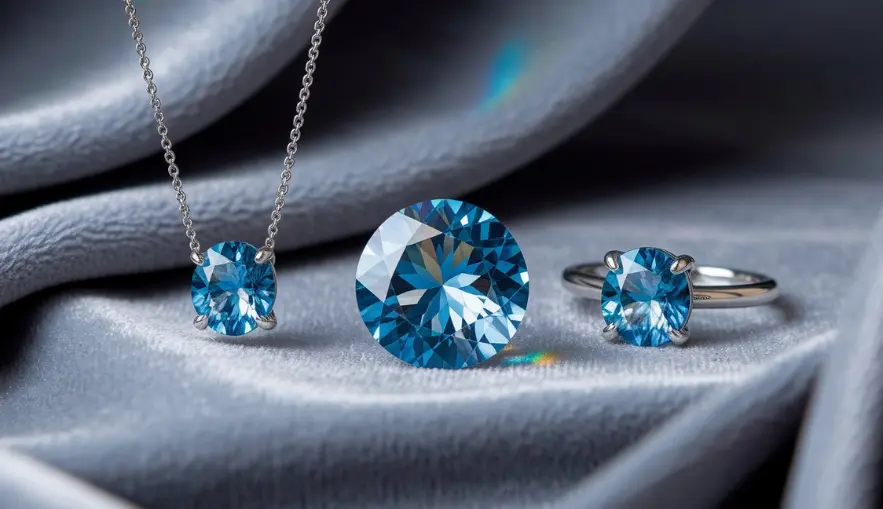
Zircon is most commonly found in brownish-red shades. But many gemstones are heated to change their color. This process can make them colorless, golden or blue. Blue zircon is the most loved color and is also a birthstone for December.
Different colors in zircon happen because of tiny amounts of other elements mixed inside, like uranium. Some zircon stones may be slightly radioactive because of this. Thats why they are heat-treated – to make them safe and stable.
Even though radiation can damage the gem’s crystal structure, zircon is very helpful in science. It’s the oldest mineral on Earth and scientists use it to learn about how our planet was formed through a method called radiometric dating.
Colorless zircon is sometimes called “Matura Diamond” because it sparkles like a diamond and shows rainbow flashes (called fire). However, zircon is more delicate than diamonds. Even though it ranks 7.5 on the Mohs hardness scale, its sharp edges can chip easily.
Some zircon stones from Australia are over 4.4 billion years old! Australia still produces the most zircon in the world-around 37% of the total. Other places that mine zircon include Thailand, Sri Lanka, Cambodia, Tanzania, Canada and the United States.
Zircon Birthstone Meaning & History
There is some debate about where the word “zircon” comes from. It might be from the Arabic word zarkun meaning “cinnabar” or “vermillion,” or it could be from the Persian word zargun, meaning “gold-colored” Both make sense because zircon comes in many colors like red orange, yellow, brown, green and blue. Colorless zircon is extra shiny and gives off rainbow-like sparkles, which is why people have confused it with diamonds for centuries.
In the Middle Ages, people believed zircon could help you sleep better and protect you from evil spirits. In Hindu tradition, zircon is one of the nine sacred gems, known as navaratna. Sometimes, it is used in place of hessonite garnet. Wearing all nine gems together is believed to bring the wearer wisdom, health and wealth.
During the Victorian era (around the 1880s), blue zircon became very popular. You can still find beautiful blue zircon stones in old English jewelry from that time.
Where Does Zircon Come From? (Origins)
Sri Lanka is known all over the world for its beautiful gemstones. You can find many stones there like sapphires (in many colors), rubies, alexandrites, spinels, tourmalines, moonstones and quartz. One special gem from Sri Lanka is zircon, which is also the birthstone for December. In the central part of Sri Lanka, there is a place called Elahera. Its full of mountains, forests and fast-moving streams. Zircon is mined here in this rich and dramatic landscape.
Another place where zircon is found is Australia, especially in the Harts Range area. This region has wide open fields, dry rivers and small hills. Zircon from here can be yellow-brown orangish-brown, pink or even purple. The main mining spot is called Zircon Hill. Nearby, there’s a city called Alice Springs, which is known for its outback culture, Aboriginal artwork and fun events like a boat race in a dry riverbed!
Zircon is usually found in places where sapphire is also found. Other countries that have both zircon and sapphire include Myanmar, Vietnam and Cambodia.
Zircon Birthstone Care & Cleaning
Zircon has a hardness of 6 to 7.5 on the Mohs scale, which means it is not as hard as some other gemstones. Many zircon stones are heat-treated to improve their colors. This process gives them shades like blue, colorless (white) orange, yellow and red. Zircon is usually stable around chemicals, but if the stone has been treated with heat, its color might fade if its left in strong sunlight for a long time.
Zircon can scratch or get damaged easily, so its better not to wear it while doing rough tasks like gardening, playing sports or washing dishes.
How to Clean Zircon:
- Use warm, soapy water: Mix some mild soap in warm water.
- Use a soft brush: Gently clean the stone with a soft-bristled brush.
- Rinse well: Wash off all the soap so your zircon shines nicely.
Don’t use: Ultrasonic or steam cleaners. These can damage the stone because zircon is sensitive to heat and strong vibrations.
Color of Zircon
Zircon is best known for its bright and beautiful blue color. But it also comes in many other shades like green, yellow, brown, red and even clear (colorless). Among all these, blue zircon is the most popular. It can look like a soft sky blue or a deep sea blue and it shines a lot, which makes it look very pretty in jewelry.
Durability of Zircon
Zircon is a strong stone and has a hardness between 6.5 and 7.5 on the Mohs scale, which means it doesn’t get scratched easily. But it can still break or chip if it falls or gets hit hard because it is a bit brittle. So, if you wear zircon jewelry every day, it’s a good idea to be careful and protect it from getting knocked or scratched.
Blue Topaz Birthstone

History & Meaning
The word “topaz” probably comes from the old Sanskrit word “tapas,” which means fire. Topaz has been known in many colors, but blue topaz became very popular in the 1900s. This happened because modern methods helped make its blue color brighter and more beautiful. For people born in December, blue topaz is a special stone. It stands for calmness, peace and clear thinking. Many people believe it helps with honest communication, emotional balance and expressing true feelings – which is great during the busy and stressful holiday season.
Color
Blue topaz comes in a few lovely shades – sky blue, Swiss blue and London blue. Sky blue is light and soft, Swiss blue is bright and strong and London blue is dark and rich. All of them shine beautifully and look very attractive in jewelry.
Durability
Blue topaz is a strong stone and scores 8 out of 10 on the Mohs hardness scale. That means it doesn’t scratch easily. But it can still break or chip if it falls or gets hit hard. So, if you wear it every day, try to be careful so it stays safe and shiny.
Where Its Found
Blue topaz is found in many countries. Brazil is the biggest producer, but it is also found in Nigeria, Sri Lanka and China. Naturally blue topaz is very rare. Thats why most of the blue topaz you see in shops is treated with heat to bring out its bright blue color.
Care & Maintenance
Taking care of blue topaz is easy. Just wash it with warm soapy water and use a soft brush to clean it gently. Don’t use machines like steam cleaners or ultrasonic cleaners-they can harm the stone. Also, try not to bump it on hard surfaces to avoid cracks or chips.
December Birthstone Colors
birthstones for december Tanzanite, Turquoise, Blue Zircon and Blue Topaz – are all loved for their beautiful blue shades. These stones look like winter – cool, peaceful and full of charm. The colors go from light sky blue to deep ocean blue and even violet-blue. Each stone has its own special color, making December one of the most colorful months for gemstones.
Tanzanite has a rich violet-blue color. Sometimes, its color changes a bit when seen in different light. People often say it looks like a sapphire. It feels fancy and a little magical. Turquoise is smooth and doesn’t sparkle. Its bright sky-blue or greenish-blue color is linked to peace, safety and good luck. People have loved it for a long time.
Blue Zircon shines brightly and usually has a clear, icy blue color. It can sparkle like a rainbow when light hits it. Blue Topaz is usually a lighter blue – like Swiss blue or London blue. It gives a fresh and clean look to any jewelry piece.
All these blue stones look great in winter-style jewelry. Whether you like dark and bold blues or soft and light shades, December birthstones have a color for every taste and personality.
List Of Birthstones for December Date Wise
Wondering which birthstone matches your exact birth date in December? Here’s a complete date-wise list of December birthstones including Tanzanite, Turquoise, Blue Zircon and Blue Topaz. Each gemstone reflects the cool and beautiful spirit of this winter month.
| Date | Birthstone |
|---|---|
| December 1st birthstone | Tanzanite |
| December 2nd birthstone | Turquoise |
| December 3rd birthstone | Blue Zircon |
| December 4th birthstone | Blue Topaz |
| December 5th birthstone | Tanzanite |
| December 6th birthstone | Turquoise |
| December 7th birthstone | Blue Zircon |
| December 8th birthstone | Blue Topaz |
| December 9th birthstone | Tanzanite |
| December 10 birthstone | Turquoise |
| December 11 birthstone | Blue Zircon |
| December 12 birthstone | Blue Topaz |
| December 13 birthstone | Tanzanite |
| December 14 birthstone | Turquoise |
| December 15 birthstone | Blue Zircon |
| December 16 birthstone | Blue Topaz |
| December 17 birthstone | Tanzanite |
| December 18 birthstone | Turquoise |
| December 19 birthstone | Blue Zircon |
| December 20 birthstone | Blue Topaz |
| December 21 birthstone | Tanzanite |
| December 22 birthstone | Turquoise |
| December 23 birthstone | Blue Zircon |
| December 24 birthstone | Blue Topaz |
| December 25 birthstone | Tanzanite |
| December 26 birthstone | Turquoise |
| December 27 birthstone | Blue Zircon |
| December 28 birthstone | Blue Topaz |
| December 29 birthstone | Tanzanite |
| December 30 birthstone | Turquoise |
| December 31 birthstone | Blue Zircon |
Frequently Asked Questions About December Birthstone
1. Is December gemstone blue topaz or turquoise?
Many people ask this and the answer is – both! December has more than one birthstone. Blue Topaz and Turquoise are very popular, but Tanzanite and Blue Zircon are also December birthstones. All of them are beautiful and have lovely blue colors.
2. What is the official color of December?
The main color linked with December birthstones is blue. This includes many shades, like soft sky blue, rich ocean blue and even violet-blue, depending on the gemstone. These cool colors match the winter season perfectly.
3. What is my birthstone if I was born in December?
If you were born in December, your birthstone could be any of the following: Tanzanite, Turquoise, Blue Zircon or Blue Topaz. Each one is special in its own way and shows off different types of blue shades, so you can choose the one you like the most.
 +91-91250-34444
+91-91250-34444


